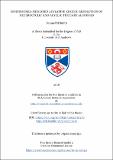Files in this item
Isothiourea-mediated acylative kinetic resolution of heterocyclic and acyclic tertiary alcohols
Item metadata
| dc.contributor.advisor | Smith, Andrew David | |
| dc.contributor.author | Smith, Samuel M. | |
| dc.coverage.spatial | xviii, 301 p. | en_US |
| dc.date.accessioned | 2018-11-15T09:36:52Z | |
| dc.date.available | 2018-11-15T09:36:52Z | |
| dc.date.issued | 2018-09-27 | |
| dc.identifier.uri | https://hdl.handle.net/10023/16470 | |
| dc.description.abstract | This thesis describes the isothiourea-catalyzed acylative kinetic resolution (KR) of heterocyclic and acyclic tertiary alcohols. The protocols developed for the resolution of these challenging substrates provide access to biologically-relevant small molecules in highly enantioenriched form. Chapter 2 describes the acylative KR of a range of 3-hydroxy-3-substituted oxindole substrates, bearing up to three potential recognition motifs at the stereogenic tertiary carbinol centre. Experimental and computational studies have identified a C=O•••isothiouronium interaction as the key stabilizing interaction for efficient enantiodiscrimination. This interaction was exploited in reactions using the isothiourea catalyst, (2S,3R)-HyperBTM, generally at low catalyst loadings (1 mol %) and isobutyric or acetic anhydride as acylating agent, enabling s values of up to > 200 (30 examples). Chapter 3 focuses on extending the KR protocol to 3-hydroxypyrrolidinone substrates, which do not possess the benzannulation present in the core structure of the substrates resolved in Chapter 2. Re-optimization of the previous KR conditions found (2S,3R)-HyperBTM (2 mol %) as catalyst, acetic anhydride (0.7 equiv.) as acylating agent, in toluene at 0 °C as optimal, enabling s values of up to > 200 to be obtained (27 examples). Variation of the substitution patterns and electronic nature of the pyrrolidinone substrates were investigated, including extension of the protocol for the KR of α-hydroxy-β- and δ-lactam derivatives. Chapter 4 investigates the complete removal of the cyclic structure of the substrate through the KR of a range of acyclic tertiary alcohols. No acylation was observed for acyclic α-hydroxy amides, and poor reactivity and selectivity was observed for α-hydroxy ketones and α-hydroxy phosphonates. However, acylation is readily achieved when using α-hydroxy esters, and this chapter focuses on the KR of these substrates. Optimization studies found (2S,3R)-HyperBTM (5 mol %) as catalyst, isobutyric anhydride (2.0 equiv.) as acylating agent in diethyl ether at rt as optimal, enabling s values of up to 140 (21 examples). The protocol is currently limited to the KR of α-hydroxy esters bearing an aromatic substituent and a methyl group at the carbinol stereocentre, with alkyl substituents larger than methyl leading to either low conversion or selectivity. | |
| dc.language.iso | en | en_US |
| dc.publisher | University of St Andrews | |
| dc.relation | Data underpinning Samuel Smith's thesis (Title and description redacted), Smith, S.M., University of St Andrews, DOI: https://doi.org/10.17630/e1e170df-9006-4348-bc1e-1c57a3c032be | en |
| dc.relation.uri | https://doi.org/10.17630/e1e170df-9006-4348-bc1e-1c57a3c032be | |
| dc.rights | Attribution-NonCommercial-NoDerivatives 4.0 International | * |
| dc.rights.uri | http://creativecommons.org/licenses/by-nc-nd/4.0/ | * |
| dc.subject.lcc | QD262.S658 | |
| dc.title | Isothiourea-mediated acylative kinetic resolution of heterocyclic and acyclic tertiary alcohols | en_US |
| dc.type | Thesis | en_US |
| dc.contributor.sponsor | University of St Andrews. School of Chemistry | en_US |
| dc.type.qualificationlevel | Doctoral | en_US |
| dc.type.qualificationname | PhD Doctor of Philosophy | en_US |
| dc.publisher.institution | The University of St Andrews | en_US |
| dc.publisher.department | School of Chemistry (University of St Andrews) | en_US |
| dc.identifier.doi | https://doi.org/10.17630/10023-16470 |
The following licence files are associated with this item:
This item appears in the following Collection(s)
Except where otherwise noted within the work, this item's licence for re-use is described as Attribution-NonCommercial-NoDerivatives 4.0 International
Items in the St Andrews Research Repository are protected by copyright, with all rights reserved, unless otherwise indicated.


